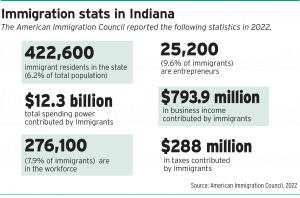Subscriber Benefit
As a subscriber you can listen to articles at work, in the car, or while you work out. Subscribe NowA new study from the Federal Reserve Bank of San Francisco suggests the immigrant population is significantly boosting the number of workers in the U. S. labor market, giving the country a little more room to breathe as it continues marching through the post-pandemic era.
The Congressional Budget Office recently revised estimates of annual net immigration numbers, gauging 3.3 million people on net immigrated to the states in 2023 and 2024.
The updated numbers are higher than past estimates due largely in part to a greater number of undocumented immigrants entering the country.
Between October 2023 and January 2024, an additional 1.3 million undocumented immigrants entered the U.S., according to the study’s author, Evgeniya Duzhak.
Using methodology from the Congressional Budget Office to measure the job vacancy-to-unemployment ratio, Duzhak’s research suggests one-fifth of the easing of the United States’ labor market tightness can be attributed to the rise in immigration.
In Indiana, the state is seeing its own labor market relief due to contributions from the immigrant community.
What the numbers tell us
The current ratio of unemployed people to job openings in Indiana is making its way back to pre-pandemic levels, sitting around 0.8 in May 2024, according to data from the U.S. Bureau of Labor Statistics.
Ratio levels for the state in 2024 are consistent with numbers seen in 2019.
Due to a Federal Open Market Committee-mandated media blackout period, Duzhak was unable to speak about immigration’s impact on the state of Indiana with the Indiana Lawyer before this deadline.
 But data from the American Immigration Council found immigrants make up a notable portion of entrepreneurs and employees in the state.
But data from the American Immigration Council found immigrants make up a notable portion of entrepreneurs and employees in the state.
As of 2022, the state of Indiana was home to 422,600 immigrants, according to the American Immigration Council. Of that number, 276,100 immigrants contributed to the labor force, compared to 226,043 workers in 2018.
Immigrant workers predominantly occupied transportation and warehousing jobs, followed by manufacturing and construction positions.
In 2018, immigrant entrepreneurs generated $497.9 million in business income. In 2022, these entrepreneurs contributed $793.9 million.
According to the American Immigration Council, immigrants fill many of the holes left behind by baby boomers transitioning into retirement.
On a national scale, immigrants are more likely to hold an advanced degree than native-born residents in the U.S., according to the council.
This same population is also more likely to have less than a high school degree, demonstrating that immigrants fill shortages across the job skills spectrum.

“I think that just speaks to another way that immigration is really important to the state because they’re able to plug in across the skills,” Micaela McConnell, State and Local Senior Policy Associate for the American Immigration Council, said.
In 2023, the state of Indiana saw a net in-migration of almost 22,500 people, marking the third year in a row the state topped its 20,000-resident migration mark, according to Matt Kinghorn, senior demographer at the Indiana Business Research Center, using data estimates by the U.S. Census Bureau.
Though the support is noticeable, the state isn’t fully in the clear.
Data from the United States Chamber of Commerce shows Indiana’s worker to job ratio is considered “severe”, on a rating scale ranging between least severe, severe, more severe and most severe. Indiana’s ratio sits at 72 available workers for every 100 open jobs in the state, faring better than many states across the U.S., like Arkansas, Virginia and Maryland, but lagging behind its neighbors, with Illinois sitting at 76 workers per 100 jobs and Michigan at 85.
Reasons for a spike in immigration
According to Duzhak, the spike in immigration nationwide can be partially attributed to delays in immigrants obtaining work authorization.
Because of expanded humanitarian parole in late 2022 and early 2023 for immigrants seeking asylum in the U.S., Duzhak estimated many who were immediately eligible for work permits had to wait an average of nine months for the permits to be processed.
“Hence, one can assume that these immigrants started getting authorizations between late 2023 and early 2024 and are expected to continue to enter the labor force throughout 2024,” she said.

Thomas Ruge, director at the Lewis Kappes law firm, said that, depending on the visa, permit processing can take anywhere from six months to six years or longer.
“It varies quite a bit, depending upon what process you’re undertaking, the shortest being for the spouse of a U.S. citizen,” Ruge said. “And then there are long waiting lines for people trying to get visas based on job offer and employment.”
Christina Arrom Garza, chief operating officer of the Immigrant Welcome Center in Indianapolis, said the organization has noticed a trend in populations of migrants arriving to Indiana.
Afghan refugees, for example, are often placed along the East Coast, but through family and other connections, make the move to Indiana.
“We’ve seen some shifts within our refugee populations as they get placed in some of these bigger cities or these different markets, and they’re looking for a more sustainable market for them,” she said.

Arrom Garza said the Immigrant Welcome Center has also started learning about how employers are marketing open positions to immigrants searching for employment.
“We’ve also started hearing a little bit about different employers, and this isn’t specific to Indianapolis, but Indiana as a whole, of employers doing targeted marketing for jobs here in Indiana in different languages,” she said. “So, one of the things we’ve heard from a few clients is that they saw a billboard, in Spanish or in Haitian Creole, saying come to Indiana, we have jobs.”
The Congressional Budget Office’s projections for population growth in the U.S. from 2024 to 2054 predict net immigration will account for all population growth in the country starting in 2040.
Fertility rates in the U.S. remain below the rate required for a generation to replace itself without immigration, according to the data. •
Please enable JavaScript to view this content.
